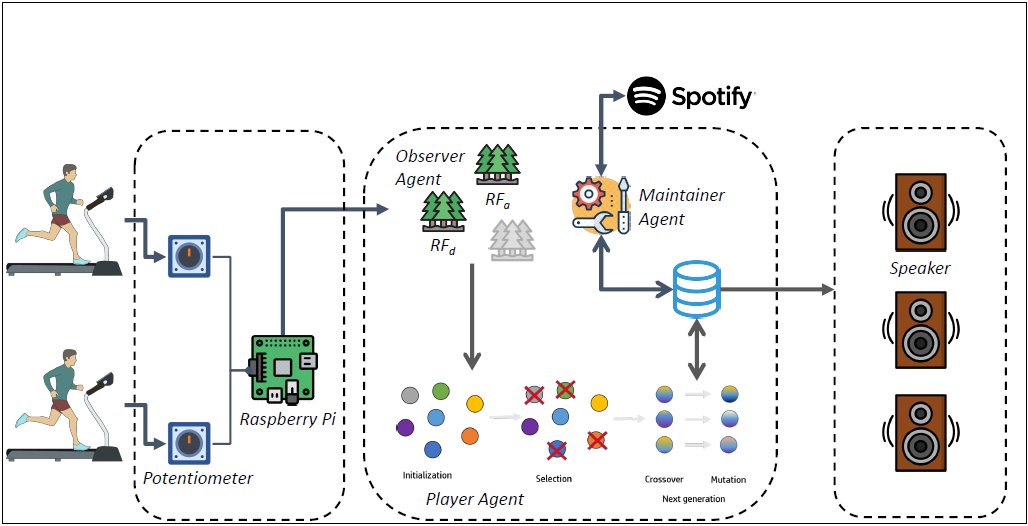Ambient Intelligence & IoT
 The term Ambient Intelligence (AmI) was coined
by the European Commission, when in 2001, the
European Community's Information Society Technology
launched the AmI challenge. The AmI paradigm deals with a new
world of ubiquitous computing devices, where physical
environments interact "intelligently" and unobtrusively
with people by taking into account of
their needs, and with the purpose of forecasting
behaviors and offering the services required.
An "intelligent" environment needs to: (i) surround the users in a non-intrusive way,
(ii) recognize users, activities or scenarios, and operate consequently, (iii)
have a predictive behavior based on knowledge deduced from the environment and specific activities of the users,
and (iv) provide services and "adequate" atmospheres in order to improve
the quality of life inside the environment itself.
The term Ambient Intelligence (AmI) was coined
by the European Commission, when in 2001, the
European Community's Information Society Technology
launched the AmI challenge. The AmI paradigm deals with a new
world of ubiquitous computing devices, where physical
environments interact "intelligently" and unobtrusively
with people by taking into account of
their needs, and with the purpose of forecasting
behaviors and offering the services required.
An "intelligent" environment needs to: (i) surround the users in a non-intrusive way,
(ii) recognize users, activities or scenarios, and operate consequently, (iii)
have a predictive behavior based on knowledge deduced from the environment and specific activities of the users,
and (iv) provide services and "adequate" atmospheres in order to improve
the quality of life inside the environment itself.
Tasks like "recognize", "predict," and "create adequate atmospheres" are in the realm of Artificial Intelligence (AI). By using AI, and more specifically Computational Intelligence (CI) techniques such as Machine Learning (ML) and Evolutionary Computation (EC), an intelligent ecosystem can be created; in such intelligent ecosystem computers, sensors, and distributed services work together to improve the user experience through the support of intuitive user interfaces. The combination of ML and EC techniques has been already explored, and represents one of the most suitable support for AmI, with several advantages. On the one hand, the capability of the AmI environment to recognize and predict can be successfully made concrete with ML methods. ML is the practice of using methods to parse data, find hidden patterns and extract knowledge from it, in order to predict something. On the other hand, the capability to provide "adequate" services and atmospheres (e.g., adequate background music) can be implemented with EC techniques. Indeed, similar tasks could be seen as combinatorial problems that consists in searching for solutions in an extremely large space. Providing smart ways to guide an algorithm designed to solve "suitability mapping" problems towards an optimal solution can be difficult due to the nature of the problem itself. Such an algorithm has to find solutions that are "evaluated" by looking at how much they are "interesting", "satisfying", "adequate"; these are not easy tasks since such qualities are challenging to be formally defined. In this context, EC, and specifically Evolutionary Algorithms (EA), appear to work quite well because they apply a continual innovation during the search of the solution, through the evolutionary operators (selection, crossover, and mutation).
AmI has grown exponentially since the advent of Internet of Things (IoT). Today, according to IoT Analytics, there are about 7 billion internet connected devices, and a study by ABI Research predicts that such a number will rise to 30 billion in the next couple of years. Such huge connectivity has determined increasingly growing opportunities for AmI systems.
To date, AmI applications have been largely explored in several contexts: education, health environments, smart cities and home design, neurocomputing, factories business, and for creating immersive exercises in a retail environments such as gyms. In the specific musical context, we have realized EvoBackMusic, an automatic real-time composer of background music customizable and applicable to several ambients, and GymIntelligence, an AmI system for gym environments, able to provide adequate music atmosphere, according to the users' physical effort during the training.
Roberto De Prisco, Alfonso Guarino, Nicola Lettieri, Delfina Malandrino, Rocco Zaccagnino.
Providing music service in Ambient Intelligence: experiments with gym athletes.
Expert Systems with Applications, Elsevier. ISSN: 0957-4174. Minor revision.
Roberto De Prisco, Delfina Malandrino, Gianluca Zaccagnino, Rocco Zaccagnino.
An Evolutionary Composer for Real-Time Background Music.
EvoMUSART 2016: 135-151.
